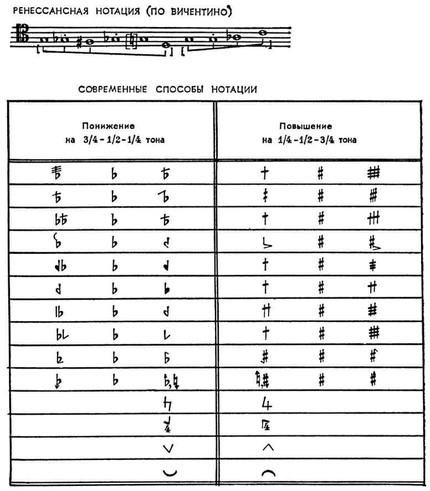
Quarter tone system |
Quarter-tone system, quarter-tone music
German Vierteltonmusik, English. quarter-tone music, French musique en quarts de ton, ital. musica a quarti di tono
The most common type of microchromatics, the sound (interval) system, the scale of which consists of sounds arranged in quarter tones. Octave to Ch. includes 24 sound stages (as defined by M. V. Matyushin, “The system of double chromatism”). To specific. Ch. s intervals, in addition to simple quarter-tones, include derivative (composite) micro-intervals – 3/4 tones, 5/4 tones, 7/4 tones, etc. When notating microtones of Ch. special characters are used (see table).


There are also special keys:

(“high key”) – the performance of one of the sections of the piece 1/4 tone higher,

(“low key”) – 1/4 tone lower. The most common types of interpretation of chis are: melismatic (microtones as a melodic decoration, singing of the main foundations), stepped (microtones as independent and equal steps of the system), sonoristic (microtones as part of timbre-sound complexes used as independent small units; see Sonorism).
Elements Ch. originally developed into music. practice and were recognized theoretically in antiquity as enharmonic microintervals. genus (see Enarmonics). Quarter tones were interpreted in the melody preim. melismatically. (For an example of the ancient Greek “enbrmona”, see the article Melodiya) Intervals Ch. are used in traditional music of a number of East. peoples (Arabs, Turks, Iranians).
In the Middle Ages, the elements of Ch. occasionally found as an echo of antique. enarmonics. Attempts to transfer the Greek frets (and genera) in modern. the practice was brought by some musicians of the 16th-17th centuries. to the use of quarter tones (in the melismatic interpretation, see the table, as well as in the stepped one, see the example in column 524). Eve of the 20th century was marked by a new wave of interest in Ch. and to microchromatics in general (among the first are the experiments of A. J. Gruss). In 1892 a book by G. A. Behrens-Zenegalden about Ch. (interpreted already in the newest sense, as a 24-step system), in which a corresponding instrument (“achromatisches Klavier”) was also proposed, in 1898 J. Fulds composed a quarter-tone string quartet. In the 1900-1910s. to Ch. Composers R. Stein, W. Möllendorff, I. A. Vyshnegradsky, C. Ives, and others applied. Czech composer and theorist A. Khaba. At the same time, the first works about Ch. in Russia (M. V. Matyushin, A. S. Lurie). In the 20s. 20th century Ch. s. studied and creatively mastered owls. composers and theorists (compositions by G. M. Rimsky-Korsakov, A. A. Kenel, N. A. Malakhovskii; theoretical works by G. M. Rimsky-Korsakov, V. M. Belyaev, A. M. Avraamov and others .). Diverse application Ch. received after the 2nd World War 1939-45: in the framework of the modern. chromatic tonality (12 semitones form a kind of “diatonic” in relation to quarter-tones), in the so-called. free atonality, in connection with seriality, especially in the sonoristic interpretation of Ch. P. Boulez, M. Kagel, S. Bussotti, A. Zimmerman, and a number of Soviet composers addressed her. Sample Ch. (sonorously colored sound of string instruments with an expressive effect of gentle sighs):

E. V. Denisov. Trio for violin, cello and pianoforte, 1st movement, bars 28-29.
References: Matyushin M. V., Guide to the study of quarter tones for violin, …, 1915; Lurie A., To the music of higher chromatism, in Sat.: “Sagittarius”, P., 1915; Belyaev V. M., Quarter-tone music, “The Life of Art”, 1925, No 18; Rimsky-Korsakov G. M., Justification of the quarter-tone musical system, “De musica”, Sat. 1, L., 1925; Kapelyush B.N., Archives of M.V. Matyushin and E.G. Guro, in the book: Yearbook of the Manuscript Department of the Pushkin House for 1974, L., 1976; Vicentino N., L antica musica ridotta alla moderna prattica, Roma, 1555, facsimile. ed., Kassel, 1959; Behrens-Senegalden GA, Die Vierteltöne in der Musik, B., 1892; Wellek A., Viertelton und Fortschritt, “NZfM”, 1925, Jahrg. 92; Wyschnegradsky I., Quartertonal music…, “Pro Musica Quarterly”, 1927; his own, Manuel d harmonie a quarts de ton, P., (1932); Haba A., Flügel und Klavier der Vierteltonmusik, “Die Musik”, 1928, Jahrg. 21, H. 3; his, Mein Weg zur Viertel- und Sechstelton-Musik, Düsseldorf, 1971; Schneider S., Mikrotöne in der Musik des 20. Jahrhunderts, Bonn, 1975; Gojowy D., Neue sowjetische Musik der 20-en Jahre, (Laaber), 1980; Ludvová J., Anton Joseph Gruss (1816-1893) a jeho ctvrttуny, “Hudebnin veda”, 1980, No 2.
Yu. N. Kholopov



